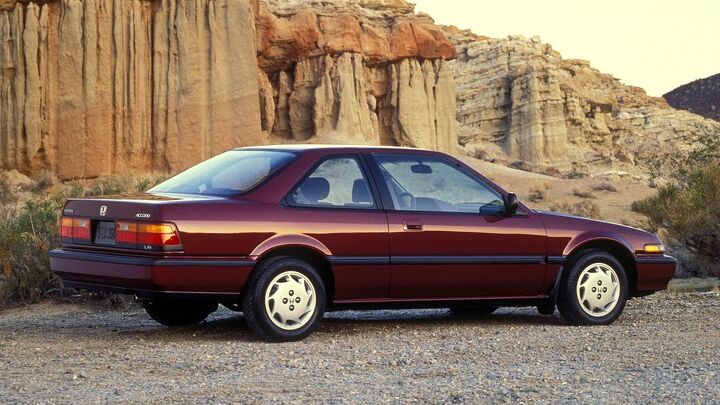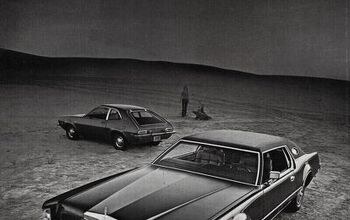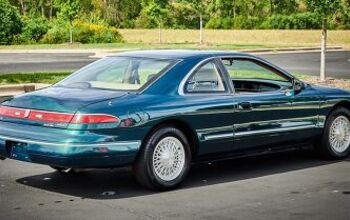Rare Rides Icons: The CA Honda Accord, It's Continental

Much like the V20 Toyota Camry covered by Rare Rides recently, Honda’s CA generation Accord was a big, important step forward for Honda’s mainstream sedan. Designed for a global market and manufactured in many different countries, the CA Accord put the nameplate on the minds of many a middle-market American consumer. Let’s take a trip back in time, to when cars were still square.
The Accord name was an established one at Honda by the mid-Eighties, as it entered production in 1976 for the ’77 model year. The Accord started out as a larger compact in its first generation (SJ), and was initially only available as a three-door hatchback. Accord was Honda’s largest car ever, as the company had concentrated mostly on Kei and subcompact cars in the past. Before Accord, Honda’s largest car was the compact 1300 sedan of 1969 to 1972. The Accord line saw a sedan added a year after introduction, and the four-door made its first North American appearance in 1979.
The second-generation Accord (SY) appeared in 1982 and looked more like a Honda with its quad square headlamps. Most dimensions increased except exterior length, which remained about the same as before. Again a three-door hatchback and four-door sedan were offered, and North American market Accords were now manufactured in Marysville, Ohio. Honda opened its Marysville Auto Plant in 1982, and it still builds Accords today. With its second-generation Honda established a cadence of Accord replacement every four years, which was adhered to through the model’s fifth generation in 1997.
That meant a new Accord was due for the 1986 model year, as Honda planned to expand the model’s reach considerably with its third generation. They called it CA, or Continental Accord. It would be the largest Accord to date and needed to appeal to audiences in almost all world markets. Honda used in-house designer Toshi Oshika for the Accord, who also applied his skills to edit the accord into the upscale Honda Vigor for the Japanese market.
The Accord’s clean-sheet redesign was finalized in 1983 and was much sleeker than its predecessor. The SY had a boxy late Seventies look: Chunky bumpers and trim looked as though they were applied as an afterthought. The CA’s design was a much more cohesive whole and looked integrated and modern. Flip-up headlamps were used for the first time, a feature blessed to the Accord because of its luxurious Vigor sibling. The headlamps were a distinguishing feature, particularly in Japan. There, Accords did not receive them as the model was positioned below the flip-up visage of the Vigor. The Vigor was even sold at a separate dealership chain. All Accords in Japan were labeled Accord CA and had fixed headlamps, to signal to onlookers that they were not luxurious.
The Accord’s new shape was part of a complete restyling at Honda that sought to unify the company’s product offerings in a singular design language. The company launched its premium Acura brand in North America for 1986, which coincided with a new upscale dealership chain in Japan called Honda Clio. Clio locations sold Honda’s new premium products like Legend, Integra, and Vigor. Non-luxury products like the Prelude and CR-X were redesigned shortly after the Accord debuted the new styling direction. With its 1986 appearance, the new Accord beat the V20 Camry to market by a whole year. It was a crucial lead at a time when the Japanese sedan market was experiencing such rapid advancements.
The new styling was applied to more Accord body styles than ever before, which varied by market. There was an Accord coupe for the first time (1988+), and the three-door hatchback returned as an Accord mainstay. The expected four-door sedan was present too, but there was a fourth option: AeroDeck. Off-limits to many markets, the AeroDeck was a three-door shooting brake. It was much cooler than the other Accords but would’ve undoubtedly been a slow seller in the US. Worth a mention: All Accord coupes of this generation were built in Ohio and then exported with right-hand drive to Japan.
The CA was built in seven different locations around the world, one more than the second-generation car. Home production at Honda’s Saitama factory was supplemented by Marysville in Ohio, Canadian production in Ontario, Pentone in New Zealand, as well as factories in Thailand, Indonesia, and Malaysia.
With its new international focus, the CA Accord arrived with a new double-wishbone suspension for which Honda became known. Accord was the first Honda product to employ wishbones front and rear. The more costly suspension setup delivered returns in better handling, and better stability at speed. All CA Accords used front sway bars, and high-level trims added bars at the rear. The Accord offered front brake discs and rear drums at low trims, or four-wheel discs if a customer was feeling flush. ABS was available for the first time on an Accord, but only on models with four-wheel discs.
Unlike the V20 Camry that offered a V6 to appeal specifically to Americans, Honda was not too interested in cylinder counts higher than four outside its luxury cars. All CA Accords used an inline-four engine, in five different varieties depending upon the market. At the lower end was a 1.6-liter, alongside two 1.8s and two 2.0s. Transmissions were two and included a rewarding five-speed manual, and a four-speed automatic. All North American cars used the 2.0-liter engines; the lower-spec A20A was good for 98 horsepower and the B20A made 120.
Accord grew considerably larger in its third generation, as it edged toward becoming the midsize car it is today. Wheelbase increased from 96.5 inches to 102.4″. Overall length on the sedan grew from 173.6 inches to 179.1″, and the hatchback was slightly shorter at 174.8 inches. Width, a key part of selling cars in the North American market, increased on the sedan from 65 inches in 1985 to a WideTrac-like 67.4 inches in 1986. Though much larger, the CA is still dwarfed by modern car heft: The current Accord is 196 inches long, and 73 inches wide.
Much of the high-level equipment on Accords sold in other markets (especially Japan) was not available in the North American and Australian markets. Home market Accords had optional niceties like heated mirrors, a full digital dash, climate control, and a power equipment package. Though not entirely spartan, North American Accords were limited in luxury scope by two things: The new Acura lineup (Legend, Integra) needed protection from any well-equipped Honda that may steal a sale, and North American consumers’ views that Honda was a builder of affordable economy cars.
At the debut, the American accord was available in three basic trim levels in the hatchback and sedan body styles. At base was the $9,587 DX ($24,036 adj.), where a hatchback was slightly more affordable than the $10,436 ($26,165 adj.) sedan. Mid-level was the LX, where the hatchback’s ask of $12,583 ($31,548 adj.) was slightly more dear than the sedan at $12,536 ($31,430 adj.). Top tier was the LXi, available only as a sedan. With its air conditioning, optional ruched leather, power door locks, alloy wheels, and power moonroof it asked $14,196 ($35,592 adj.).
There were not a lot of changes over the CA Accord’s four-year run, apart from the addition of the conservative coupe for the non-Prelude buyer of 1988. For its final year in 1989, the U.S. market received a new sporty Accord, the SE-i. The hatchback was excluded from SE-i, but sedan and coupe buyers received standard alloy wheels, the best four-wheel disc brakes, leather as standard, factory window tint, and full power equipment. The ultimate luxury Accord of the Eighties was limited to two conservatively chosen colors for sedan and coupe. Sedan customers chose from charcoal with gray interior or taupe with beige. Coupes were more exciting with their gray over gray, and teal over beige options. The SE-i asked $18,215 ($41,935 adj.) for the well-heeled Honda buyer in 1989. The most Honda will charge you for an Accord today is $38,050 for the 2.0T Touring.
The CA Accord expanded the model’s prominence around the globe and was particularly important to Honda’s North American operations. In its final third-gen year in 1989, the Accord became the first imported car crowned the best-selling automobile in the United States. By then Honda was ready to debut an even better Accord for the Nineties – the CB7 – which again beat the new Camry to market by a year. But that’s a story for another day.
[Images: Honda]

Interested in lots of cars and their various historical contexts. Started writing articles for TTAC in late 2016, when my first posts were QOTDs. From there I started a few new series like Rare Rides, Buy/Drive/Burn, Abandoned History, and most recently Rare Rides Icons. Operating from a home base in Cincinnati, Ohio, a relative auto journalist dead zone. Many of my articles are prompted by something I'll see on social media that sparks my interest and causes me to research. Finding articles and information from the early days of the internet and beyond that covers the little details lost to time: trim packages, color and wheel choices, interior fabrics. Beyond those, I'm fascinated by automotive industry experiments, both failures and successes. Lately I've taken an interest in AI, and generating "what if" type images for car models long dead. Reincarnating a modern Toyota Paseo, Lincoln Mark IX, or Isuzu Trooper through a text prompt is fun. Fun to post them on Twitter too, and watch people overreact. To that end, the social media I use most is Twitter, @CoreyLewis86. I also contribute pieces for Forbes Wheels and Forbes Home.
More by Corey Lewis
Latest Car Reviews
Read moreLatest Product Reviews
Read moreRecent Comments
- Theflyersfan I think color is FINALLY starting to return to car lots. After what seems like over a lost decade of nothing but shades of gray, whites, and black, I'm seeing a lot more reds and blues creeping into luxury car lots. Except Audi and Volvo. They still have at least 6-8 shades of gray/silver. But they at least have a nice green. Honda and Acura seem to have a bunch of new colors. And all carmakers need to take a serious look at the shades of red seen at the Alfa Romeo lot and tell themselves they want that because that looks amazing.
- Bd2 Well, it's no Sonata, no does it have the panache of the Optima.
- Teddyc73 "eye-searingly"?
- Teddyc73 I applaud anyone who purchases a vibrant, distinct or less popular color. We need these people. Our road ways have turned into a dreary gloomy sea of white, black, silver and greys, most with the equally lifeless black wheels. Mr Healey is guilty of contributing to this gloom apparently. It looks like a black and white movie across the nation when grouped with our grey houses with grey interiors. Totally dull and lifeless. And what is with this awful hideous trend of dull grey with black wheels showing up everywhere? It's on everything. Just awful. Come on people! I'll keep my Ram 1500 with it's deep rich sparkling Western Brown paint as long as I can.
- Shipwright As my Avatar shows I had an '08 GT 500, Grabber Orange convertible. I now own a '12 GT 500 Kona Blue coupe.









































Comments
Join the conversation
Corey, Look what you started. Now do the Toyotas and Mazdas.
I have the 89 SE-I teal with Beige. It is in great shape and only has 26k mile on it. It’s in great shape and I love driving that car. Thanks for posting this article I never knew how rare this car is. I’m glad to have in my garage. I’m going to take it to car shows and see if other like as much as I do. I may even throw my 1969 Ct70 silver tag in the trunk and bring it too.